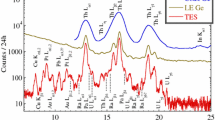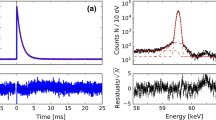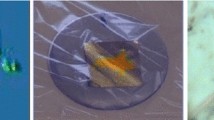Abstract
Cryogenic high-resolution \(\gamma \)-ray detectors can improve the accuracy of non-destructive assay (NDA) of nuclear materials in cases where conventional high-purity germanium detectors are limited by line overlap or by the Compton background. We have improved the performance of gamma detectors based on metallic magnetic calorimeters (MMCs) by separating the 0.5 \(\times \) 2 \(\times \) 0.25 mm\(^{3}\) Au absorber from the Au:Er sensor with sixteen 30-\(\upmu \)m-diameter Au posts. This ensures that the entire \(\gamma \)-ray energy thermalizes in the absorber before heating the Au:Er sensor, and improves the energy resolution at 35 mK to as low as 90 eV FWHM at 60 keV. This energy resolution enables the direct detection of \(\gamma \)-rays from Pu-242, an isotope that cannot be measured by traditional NDA and whose concentration is therefore inferred through correlations with other Pu isotopes. The Pu-242 concentration of 11.11 \(\pm \) 0.42 % measured by NDA with MMCs agrees with mass spectrometry results and exceeds the accuracy of correlation measurements.
Similar content being viewed by others
Avoid common mistakes on your manuscript.
1 Introduction
Safeguarding nuclear materials requires the accurate assay of fissile isotopes throughout the nuclear fuel cycle [1]. Destructive assay (DA) based on mass spectrometry provides the highest accuracy, but requires the time consuming chemical separation of different elements. Non-destructive assay (NDA) based on \(\gamma \)-spectroscopy with high-purity germanium (HPGe) detectors is less accurate, but it can be automated and it is faster and less expensive. NDA is therefore preferred as long as it can provide the required accuracy for a specific application. A case where NDA currently fails is the determination of Pu-242 content in Pu-based compounds. This is due to the fact that HPGe detectors cannot resolve the weak Pu-242 \(\gamma \) lines from much stronger lines with similar energies due to other Pu isotopes. The concentration of Pu-242 is therefore typically inferred indirectly through correlations with the concentration of other Pu isotopes [1, 2]. However, these correlations introduce systematic errors, especially for high burn-up fuel when Pu-242 concentrations can approach 10 % [2]. These errors are unacceptably high when large amounts of Pu need to be assayed, such as at reprocessing plants that process tons of Pu from nuclear fuel each year.
Cryogenic \(\gamma \)-detectors can overcome some of the limitations of HPGe detectors in nuclear safeguards due to their higher energy resolution and higher peak-to-background ratio [3–8]. This motivates our development of \(\gamma \)-detectors based on metallic magnetic calorimeters [8]. Here, we illustrate the use of MMC \(\gamma \)-detectors in a nuclear safeguards application with a direct measurement of Pu-242 \(\gamma \)-rays, and show that our MMCs have sufficient energy resolution for NDA of Pu samples that contain Pu-242.
2 Experiment
The MMC \(\gamma \)-detector fabrication is based on the maXs-200 detector design developed at Heidelberg University [6]. This design is characterized by two superconducting meander-shaped pickup coils connected in a gradiometric configuration to form a closed loop. Each of the pickup coils covers an area of 0.5\(\times \)2 mm\(^{2}\), and the Au:Er (850 ppm) sensor is deposited on top of them. To adapt these devices for high-resolution \(\gamma \)-detection, we have developed a process that separates the 150-\(\upmu \)m-thick Au absorber from the Au:Er sensor by 16 Au posts with 30 \(\upmu \)m diameter and 5 \(\upmu \)m height. This reduced contact between absorber and sensor ensures that the entire \(\gamma \)-energy is thermalized in the absorber before heating the Au:Er sensor, and prevents line broadening due to the escape of athermal phonons into the Si substrate.
The post dimensions were defined using AZ 6632 negative photoresist, and the mold for the absorber was formed with a spin-casting process using AZ 125 nXT photoresist [9]. The resist was spun on at 1500 rpm for 2 s for a mold thickness of 300 \(\upmu \)m, baked for 6 h at a temperature of 105 \(^\circ \)C, exposed to UV light, and developed using AZ 326 MIF. After ion cleaning the underlying Au:Er surface to ensure good adhesion and thermal coupling, the Au posts and absorber were electroplated onto the Au:Er sensor at a rate of \(\sim \)0.3 \(\upmu \)m/min to a thickness of \(\sim \)150 \(\upmu \)m.
The detector chip and the first-stage SQUID amplifier were mounted on a Cu holder, surrounded by a superconducting Nb shield with a 5-mm-diameter hole for collimation, and installed in a liquid-cryogen-free adiabatic demagnetization refrigerator (ADR).
To demonstrate the performance of these detectors in nuclear safeguards applications, we prepared a mixed-isotope Pu source by adding Pu-242 to a solution of weapons-grade plutonium that consisted of Pu-239, Pu-240, and small quantities of impurities and decay products. Destructive assay by mass spectrometry showed the sample contained 83.75 \(\pm \) 0.13 % Pu-239, 5.39 \(\pm \) 0.01 % Pu-240, and 10.81 \(\pm \) 0.02 % Pu-242 by atom fraction. The solution was dried inside a small Al holder that could be closed with a thin lid for containment. The source and an Al filter were mounted in the ADR at 4 K in front of the collimating hole in the Nb shield, so that the MMC recorded \(\gamma \)-rays at a rate of a few counts per second. The ADR was not temperature regulated but cooled to its base temperature of 32 mK and allowed to warm by a few mK during a run. This allowed \(\sim \)24 hours of data acquisition per ADR cycle but required a drift correction to compensate for the pulse height reduction by \(\sim \)4% at higher temperature. For this, we calculated the drift with a running average of 150 events of the strong Pu-239 line at 51.624 keV, and applied the same correction to all lines in the spectrum.
MMC \(\gamma \)-spectrum of the Pu source (bottom), compared to that of a statistics-limited Ge detector (top). All unlabeled lines are due to the escape of Au and Ge K\(_\alpha \)1 and K\(_\alpha \)2 X-rays from the two detectors. The inset shows the region around 45 keV with the Pu-242 \(\gamma \)-emission (Color figure online)
All \(\gamma \)-induced waveforms of the two pixels were captured, separated according to their polarity, and processed off-line with a trapezoidal filter. The energy was calibrated with a linear fit to the Gaussian centroids of the strongest lines in the spectrum, and 24 spectra from 12 ADR cycles could be added to improve the statistical accuracy of the measurement without loss in the energy resolution of 140 eV FWHM (Fig. 1). The sum spectrum contains \(\sim \)1.5\(\times \)10\(^{6}\) events, and is dominated by emissions from the isotopes of Pu-239 and Pu-240 as expected. The small signal at 44.915 keV is the only signature in the spectrum that indicates the presence of Pu-242. It is hidden in the wings of the much stronger Pu-240 emission at 45.244 keV when using a Ge detector but clearly separated in the MMC spectrum (inset Fig. 1). This allows using the MMC spectrum for quantitative analysis of the Pu source.
3 NDA with MMCs
Non-destructive assay (NDA) of nuclear materials determines the abundance of isotopes from the measured intensity of the corresponding \(\gamma \)-rays, taking into account the branching ratios of the different lines and their relative detection efficiency. The detection efficiency changes as a function of energy depending on the composition and the dimensions of the source, the detector, and the intervening materials. Uncertainties in relative detection efficiency therefore cause systematic errors in the assay, especially if the composition of the source and thus its absorption properties are unknown.
In addition, current NDA codes such as FRAM [10] always assume the use of a Ge-based \(\gamma \)-detector, whose detection efficiency is substantially different from that of a Au-based MMC detector. This causes assays based on existing NDA codes to provide isotopic compositions that systematically differ from the DA (mass spectrometry) values by several standard deviations. We have therefore used the measured intensities of the strong Pu \(\gamma \)-rays at 38.661, 51.624, and 56.828 keV (cf. Fig. 1) and the known branching ratios of these lines to calculate a custom curve of the detection efficiency. For this relatively small energy range, we could model the detection efficiency as a product of self-absorption in the Pu source (thickness \(d_{\text {Pu}}\)), transmission of the Al source holder and filter (\(d_{\text {Al}}\)), and absorption of the Au absorber (\(d_{\text {Au}}\)) according to
The data used for the energy-dependent absorption coefficients \(\mu \) were taken from the ENDF VII.1 photo-atomic library [11], using the total photon cross section (MT 501) to calculate absorption in the Pu source and the Al filter, and the photoelectric cross section (MT 522) to calculate the efficiency of the Au absorber. We then used a least square fit to extract the effective thickness d\(_{Pu}\) of the Pu source and the proportionality constant in Eq. (1). The resulting efficiency differed slightly from the Ge-based curve in FRAM by several percent in the energy range of interest (Fig. 2).
Detection efficiency for the experimental setup according to Eq. (1) (solid line) and according to FRAM (dashed line) (Color figure online)
Based on this efficiency curve, the Pu concentrations of the sample from NDA with MMCs agree with the reference values obtained by DA within the uncertainty of the measurement (Table 1). This includes the concentration of Pu-242 that cannot be detected directly with Ge detectors and whose relative accuracy of 0.42/11.11 = 3.8 % is already better than typical correlation measurements [2]. At this point, the Pu-242 uncertainty is still limited by the statistical error in the number of counts in the Pu-242 peak, which means that it can be further improved with detector arrays.
In summary, we have built an MMC \(\gamma \)-detector whose Au absorber is separated from the Au:Er sensor by sixteen 30-\(\upmu \)m-diameter Au posts so that the \(\gamma \)-energy fully thermalizes in the absorber. Its energy resolution of \(\sim \)140 eV FWHM at 35 mK is sufficient to directly detect the weak Pu-242 \(\gamma \)-ray at 44.915 keV and enable NDA on Pu samples that contain Pu-242. The relative accuracy of \(\pm \)3.8% is currently still limited by the counting statistics of the Pu-242 line, and can be improved by developing MMC \(\gamma \)-detector arrays.
References
D. Reilly, N. Ensslin, H. Smith, Jr., S. Kreiner, Passive Non-Destructive Assay of Nuclear Materials, Office of Nuclear Regulatory Research (NUREG/CR-5550), Washington (1991)
G. Bignan, W. Ruhter, H. Ottmar, A. Schubert, C. Zimmerman, ESARDA Bull. 28, 16 (1998)
M.F. Cunningham et al., Appl. Phys. Lett. 81, 159–161 (2002). doi:10.1063/1.1489486
W.B. Doriese et al., Appl. Phys. Lett. 90, 193508 (2007). doi:10.1063/1.2738371
A. Fleischmann et al., AIP Conf. Proc. 1185, 571 (2009). doi:10.1063/1.3292407
C. Pies et al., J. Low Temp. Phys. 167, 269 (2012). doi:10.1007/s10909-012-0557-z
D.A. Bennett et al., Rev. Sci. Inst. 83, 093113 (2012). doi:10.1063/1.4754630
C.R. Bates, C. Bates, S. Kempf, L. Gastaldo, A. Fleischmann, C. Enss, S. Friedrich, J. Low. Temp. Phys. 176, 631 (2014). doi:10.1007/s10909-013-1063-7
M. Staab, F. Greiner, M. Schlosser, H. Schlaak, J. Microelectromech. Syst. 20, 794 (2011). doi:10.1109/JMEMS.2011.2159098
T.E. Sampson, T.E. Kelley, Appl. Radiat. Isot. 48, 1543–1548 (1997). doi:10.1016/S0969-8043(97)00154-1
M. Chadwick et al., Nucl. Data Sheets 112, 2887 (2011). doi:10.1016/j.nds.2011.11.002. Special Issue on ENDF/B-VII.1 Library
Acknowledgments
We thank R. Henderson for fabricating the mixed-isotope Pu source. We gratefully acknowledge funding by the U.S. Department of Energy Office of Non-Proliferation Research NA-22 under grant LL12-MagMicro-PD2Ja. This work was performed under the auspices of the U.S. Department of Energy by Lawrence Livermore National Laboratory under Contract DE-AC52-07NA27344.
Author information
Authors and Affiliations
Corresponding author
Rights and permissions
About this article
Cite this article
Bates, C., Pies, C., Kempf, S. et al. Direct Detection of Pu-242 with a Metallic Magnetic Calorimeter Gamma-Ray Detector. J Low Temp Phys 184, 351–355 (2016). https://doi.org/10.1007/s10909-015-1348-0
Received:
Accepted:
Published:
Issue Date:
DOI: https://doi.org/10.1007/s10909-015-1348-0






